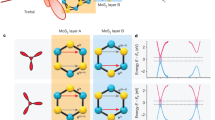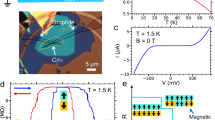Abstract
Hybrid organic–inorganic perovskites exhibit strong spin–orbit coupling1, spin-dependent optical selection rules2,3 and large Rashba splitting4,5,6,7,8. These characteristics make them promising candidates for spintronic devices9 with photonic interfaces. Here we report that spin polarization in perovskites can be controlled through chemical design as well as by a magnetic field. We obtain both spin-polarized photon absorption and spin-polarized photoluminescence in reduced-dimensional chiral perovskites through combined strategies of chirality transfer and energy funnelling. A 3% spin-polarized photoluminescence is observed even in the absence of an applied external magnetic field owing to the different emission rates of σ+ and σ− polarized photoluminescence. Three-dimensional perovskites achieve a comparable degree of photoluminescence polarization only under an external magnetic field of 5 T. Our findings pave the way for chiral perovskites as powerful spintronic materials.
This is a preview of subscription content, access via your institution
Access options
Access Nature and 54 other Nature Portfolio journals
Get Nature+, our best-value online-access subscription
$29.99 / 30 days
cancel any time
Subscribe to this journal
Receive 12 print issues and online access
$209.00 per year
only $17.42 per issue
Buy this article
- Purchase on Springer Link
- Instant access to full article PDF
Prices may be subject to local taxes which are calculated during checkout




Similar content being viewed by others
References
Zhang, C. et al. Magnetic field effects in hybrid perovskite devices. Nat. Phys. 11, 427–434 (2015).
Odenthal, P. et al. Spin-polarized exciton quantum beating in hybrid organic–inorganic perovskites. Nat. Phys. 13, 894–899 (2017).
Giovanni, D. et al. Highly spin-polarized carrier dynamics and ultralarge photoinduced magnetization in CH3NH3PbI3 perovskite thin films. Nano Lett. 15, 1553–1558 (2015).
Niesner, D. et al. Giant Rashba splitting in CH3NH3PbBr3 organic–inorganic perovskite. Phys. Rev. Lett. 117, 126401 (2016).
Zhai, Y. et al. Giant Rashba splitting in 2D organic–inorganic halide perovskites measured by transient spectroscopies. Sci. Adv. 3, e1700704 (2017).
Kim, M., Im, J., Freeman, A. J., Ihm, J. & Jin, H. Switchable S = 1/2 and J = 1/2 Rashba bands in ferroelectric halide perovskites. Proc. Natl Acad. Sci. USA 111, 6900–6904 (2014).
Isarov, M. et al. Rashba effect in a single colloidal CsPbBr3 perovskite nanocrystal detected by magneto-optical measurements. Nano Lett. 17, 5020–5026 (2017).
Mosconi, E., Etienne, T. & De Angelis, F. Rashba band splitting in organohalide lead perovskites: bulk and surface effects. J. Phys. Chem. Lett. 8, 2247–2252 (2017).
Pulizzi, F. Spintronics. Nat. Mater. 11, 367 (2012).
Chappert, C., Fert, A. & Van Dau, F. N. The emergence of spin electronics in data storage. Nat. Mater. 6, 813–823 (2007).
Ohno, Y. et al. Electrical spin injection in a ferromagnetic semiconductor heterostructure. Nature 402, 790–792 (1999).
Ghali, M., Ohtani, K., Ohno, Y. & Ohno, H. Generation and control of polarization-entangled photons from GaAs island quantum dots by an electric field. Nat. Commun. 3, 661 (2012).
Fiederling, R. et al. Injection and detection of a spin-polarized current in a light-emitting diode. Nature 402, 787–790 (1999).
Edelstein, V. M. Spin polarization of conduction electrons induced by electric current in two-dimensional asymmetric electron systems. Solid State Commun. 73, 233–235 (1990).
Stranks, S. D.et al. Electron–hole diffusion lengths exceeding 1 micrometer in an organometal trihalide perovskite absorber. Science 342, 341–344 2013).
Juarez-Perez, E. J. et al. Photoinduced giant dielectric constant in lead halide perovskite solar cells. J. Phys. Chem. Lett. 5, 2390–2394 (2014).
Shi, D. et al. Low trap-state density and long carrier diffusion in organolead trihalide perovskite single crystals. Science 347, 519–522 (2015).
Zhu, H. et al. Lead halide perovskite nanowire lasers with low lasing thresholds and high quality factors. Nat. Mater. 14, 636–642 (2015).
Eperon, G. E.et al. Perovskite–perovskite tandem photovoltaics with optimized band gaps. Science 354, 861–865 2016).
Tsai, H. et al. High-efficiency two-dimensional Ruddlesden–Popper perovskite solar cells. Nature 536, 312–316 (2016).
Bi, D. et al. Polymer-templated nucleation and crystal growth of perovskite films for solar cells with efficiency greater than 21%. Nat. Energy 1, 16142 (2016).
Yuan, M. et al. Perovskite energy funnels for efficient light-emitting diodes. Nat. Nanotech. 11, 872–877 (2016).
Wang, N. et al. Perovskite light-emitting diodes based on solution-processed self-organized multiple quantum wells. Nat. Photon. 10, 699–704 (2016).
Zhang, Q., Ha, S. T., Liu, X., Sum, T. C. & Xiong, Q. Room-temperature near-infrared high-Q perovskite whispering-gallery planar nanolasers. Nano Lett. 14, 5995–6001 (2014).
Lin, Q., Armin, A., Burn, P. L. & Meredith, P. Filterless narrowband visible photodetectors. Nat. Photon. 9, 687–694 (2015).
Wei, H. et al. Sensitive X-ray detectors made of methylammonium lead tribromide perovskite single crystals. Nat. Photon. 10, 333–339 (2016).
Sun, D. et al. Spintronics of organometal trihalide perovskites. Preprint at https://arxiv.org/abs/1608.00993 (2016).
Kepenekian, M. et al. Rashba and Dresselhaus effects in hybrid organic–inorganic perovskites: from basics to devices. ACS Nano 9, 11557–11567 (2015).
Canneson, D. et al. Negatively charged and dark excitons in CsPbBr3 perovskite nanocrystals revealed by high magnetic fields. Nano Lett. 17, 6177–6183 (2017).
Hsiao, Y. C., Wu, T., Li, M. & Hu, B. Magneto-optical studies on spin-dependent charge recombination and dissociation in perovskite solar cells. Adv. Mater. 27, 2899–2906 (2015).
Fu, M. et al. Neutral and charged exciton fine structure in single lead halide perovskite nanocrystals revealed by magneto-optical spectroscopy. Nano Lett. 17, 2895–2901 (2017).
Billing, D. G. & Lemmerer, A. Synthesis and crystal structures of inorganic–organic hybrids incorporating an aromatic amine with a chiral functional group. CrystEngComm 8, 686–695 (2006).
Ahn, J. et al. A new class of chiral semiconductors: chiral-organic-molecule-incorporating organic–inorganic hybrid perovskites. Mater. Horiz. 4, 851–856 (2017).
Xing, G. et al. Transcending the slow bimolecular recombination in lead-halide perovskites for electroluminescence. Nat. Commun. 8, 14558 (2017).
Riehl, J. P. & Richardson, F. S. Circularly polarized luminescence spectroscopy. Chem. Rev. 86, 1–16 (1986).
Lightner, D. A. & Gurst, J. E. Organic Conformational Analysis and Stereochemistry from Circular Dichroism Spectroscopy Ch. 3 (Wiley, New York, NY, 2010).
Ben-Moshe, A., Teitelboim, A., Oron, D. & Markovich, G. Probing the interaction of quantum dots with chiral capping molecules using circular dichroism spectroscopy. Nano Lett. 16, 7467–7473 (2016).
Schellman, J. A. & Oriel, P. Origin of the cotton effect of helical polypeptides. J. Chem. Phys. 37, 2114–2124 (1962).
Slavney, A. H. et al. Chemical approaches to addressing the instability and toxicity of lead-halide perovskite absorbers. Inorg. Chem. 56, 46–55 (2017).
Jiang, C. et al. Zeeman splitting via spin-valley-layer coupling in bilayer MoTe2. Nat. Commun. 8, 802 (2017).
Hilborn, R. C. Einstein coefficients, cross-sections, F values, dipole-moments, and all that. Am. J. Phys. 50, 982–986 (1982).
Acknowledgements
This publication is based, in part, on work supported by an award (KUS-11-009-21) from the King Abdullah University of Science and Technology (KAUST), by the Ontario Research Fund Research Excellence Program, by the Ontario Research Fund (ORF), and by the Natural Sciences and Engineering Research Council (NSERC) of Canada. W.G., C.J. and G.L. acknowledge support from the Singapore National Research Foundation through a 2015 NRF fellowship grant (NRF-NRFF2015-03), Singapore Ministry of Education via an AcRF Tier2 grant (nos. MOE2016-T2-2-077 and MOE2017-T2-1-163) and the A*Star QTE Programme. Q.X. acknowledges financial support from Singapore National Research Foundation via an Investigatorship Award (NRF-NRFI2015-03) and a Competitive Research Programme (NRF-CRP14-2014-03), and the Singapore Ministry of Education through AcRF Tier 2 and Tier 1 grants (MOE2015-T2-1-047 and RG 113/16). G.X. acknowledges financial support from Macau Science and Technology Development Fund (FDCT-116/2016/A3, FDCT-091/2017/A2), a Research Grant (SRG2016-00087-FST, MYRG2018-00148-IAPME) from the University of Macau, the Natural Science Foundation of China (91733302, 61605073 and 2015CB932200) and the Young 1000 Talents Global Recruitment Program of China. X.R.W. acknowledges support from a Nanyang Assistant Professorship grant from Nanyang Technological University and Academic Research Fund Tier 1 (RG108/17S) from the Singapore Ministry of Education. G.L. acknowledges the International Postdoctoral Exchange Fellowship Program of the Office of China Postdoctoral Council. H.Y. acknowledges the Research Foundation-Flanders (FWO Vlaanderen) for a postdoctoral fellowship. The authors thank A.S. Namin (QU), R.G. Sabat (QU), J.-M. Nunzi (QU), A. Xia (ICCAS) and X. Wang (ICCAS) for measuring the room-temperature SPPL. The authors thank C. Zhang (ICCAS) and Z.V. Vardeny (University of Utah) for helpful discussions. The authors also thank E. Palmiano, R. Wolowiec and D. Kopilovic for their help during the course of this study.
Author information
Authors and Affiliations
Contributions
G.L., S.H. and E.H.S. conceived the idea and designed the experiments. G.L., R.S., Z.Y., W.G., Q.X. and E.H.S. wrote the manuscript. G.L. fabricated thin films with help from L.Q. and J.X. G.L. prepared chiral ammonium salts and performed measurements (CD, PL, PLE, PLQY, TAS and XRD) with help from R.S., G.W., M.W., X.G., Q.L. and D.S. R.S. and G.X. analysed the TAS data. Z.Y. and R.Q.-B. performed the GIWAXS measurement. C.J., W.G., X.L.W., Q.X., G.W. and H.Y. performed the SSPL measurement. C.J., A.R., W.G., M.W., G.L, M.Z., X.W., O.V. and M.A. performed the SSPL data analysis and discussion. A.R. built the mathematics model for magnetic field-dependent SPPL for RDCP. All authors read and commented on the manuscript.
Corresponding authors
Ethics declarations
Competing interests
The authors declare no competing interests.
Additional information
Publisher’s note: Springer Nature remains neutral with regard to jurisdictional claims in published maps and institutional affiliations.
Supplementary information
Supplementary Information
Fabrication, circular dichroism analysis, absorption spectra and theoretical model
Rights and permissions
About this article
Cite this article
Long, G., Jiang, C., Sabatini, R. et al. Spin control in reduced-dimensional chiral perovskites. Nature Photon 12, 528–533 (2018). https://doi.org/10.1038/s41566-018-0220-6
Received:
Accepted:
Published:
Issue Date:
DOI: https://doi.org/10.1038/s41566-018-0220-6
This article is cited by
-
Chiral materials and mechanisms for circularly polarized light-emitting diodes
Nature Photonics (2024)
-
Large exchange-driven intrinsic circular dichroism of a chiral 2D hybrid perovskite
Nature Communications (2024)
-
Creating chirality in the nearly two dimensions
Nature Materials (2024)
-
Universal machine learning aided synthesis approach of two-dimensional perovskites in a typical laboratory
Nature Communications (2024)
-
Ultrafast optical investigation of carrier and spin dynamics in low-dimensional perovskites
Science China Technological Sciences (2024)



